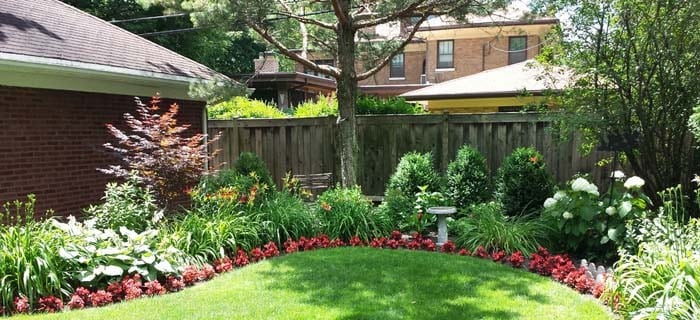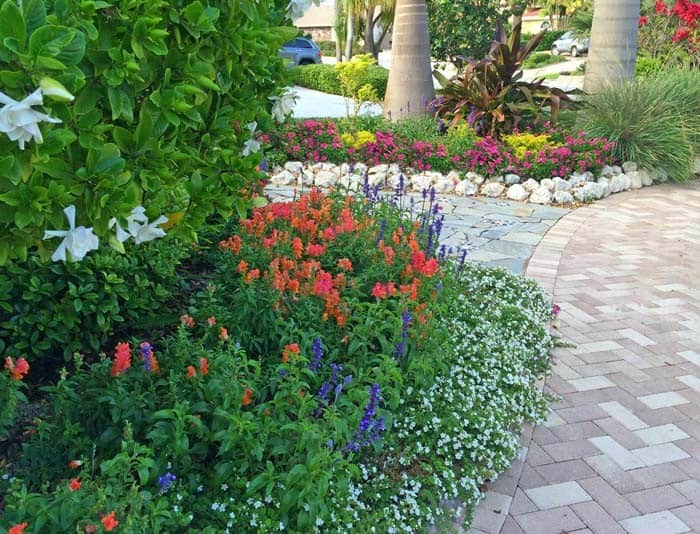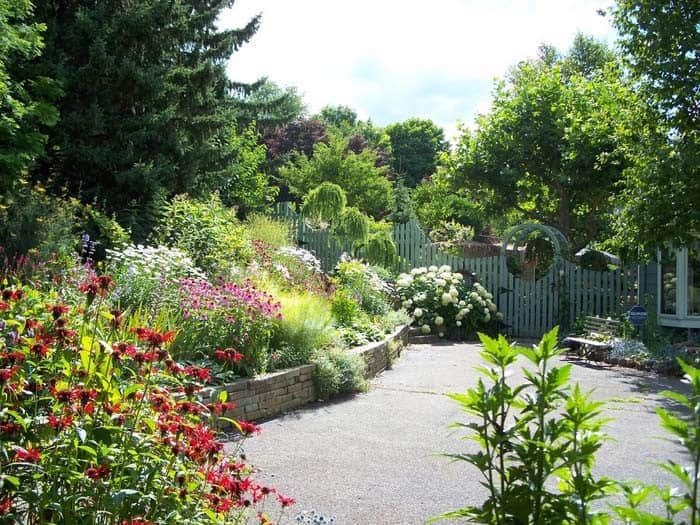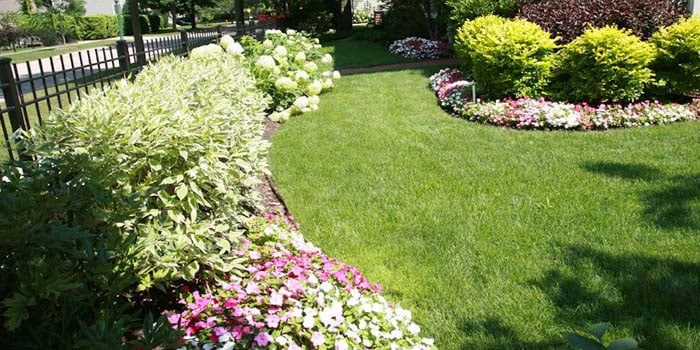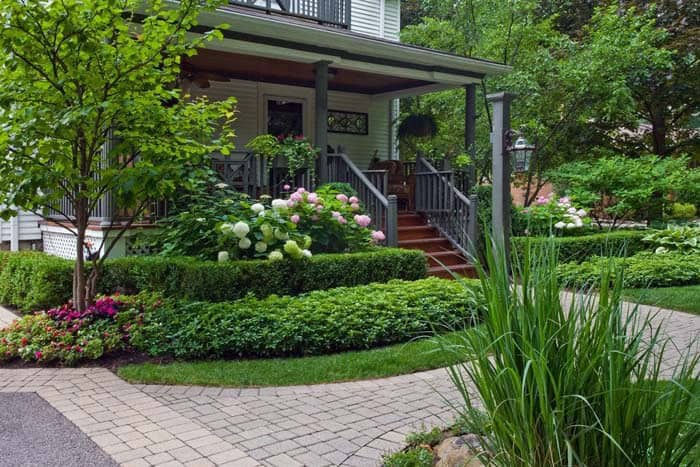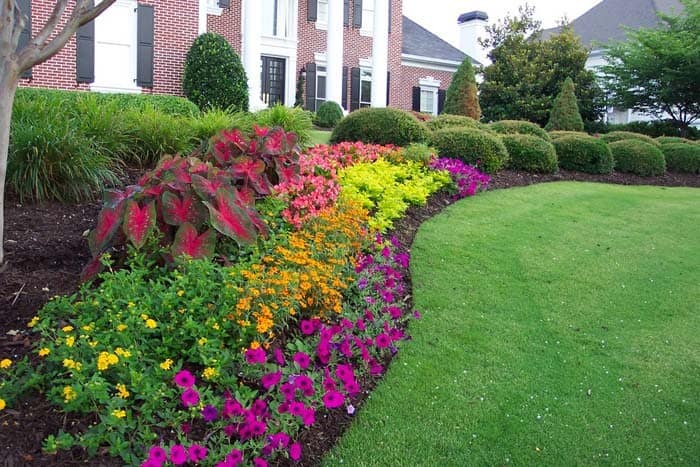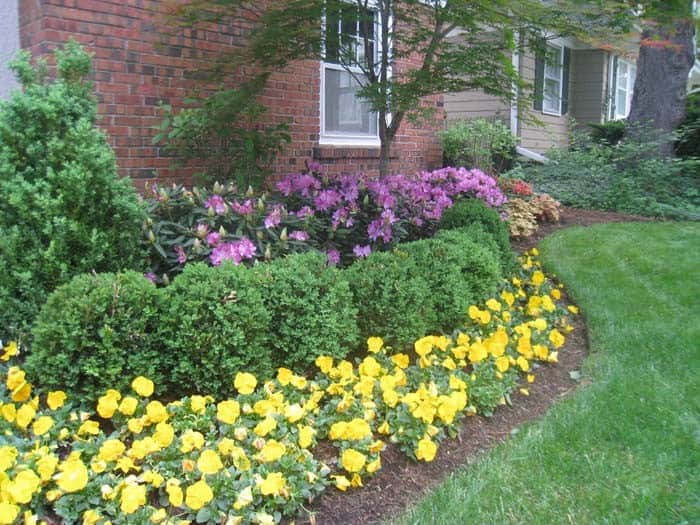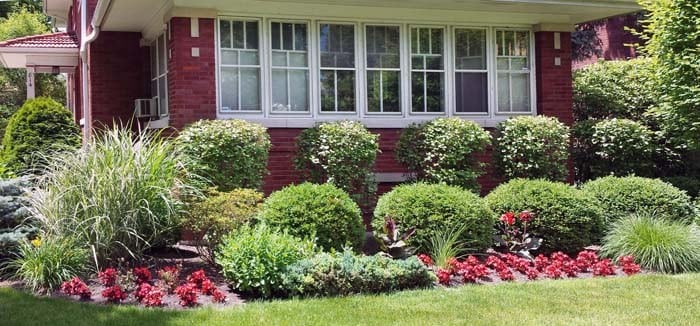If you’ve been consistently planting gardens without achieving the desired results, it may be time to consider the benefits of layered landscaping. This technique is a game-changer for many landscape designers, as it brings depth and vibrancy to any outdoor space. By incorporating different heights and colors, you can create a lush and visually appealing garden that exceeds your expectations.
At its core, layered landscaping involves planting flowers and shrubs in a way that creates distinct layers of height, adding depth and dimensionality to the garden. To design a layered garden, consider the following key elements: height and color. Think of it like creating a class picture – the tallest plants go in the background layer, while ground cover or low-growing flowers take center stage up front.
To add height to your landscape, incorporate trees, arborvitae, shrubs, or very tall flowers towards the back of a garden bed. Container gardening can also achieve this by placing tall flowers at its center. By incorporating these elements, you’ll be well on your way to creating a stunning layered landscape that showcases your personal style.
Coastal Layered Landscape
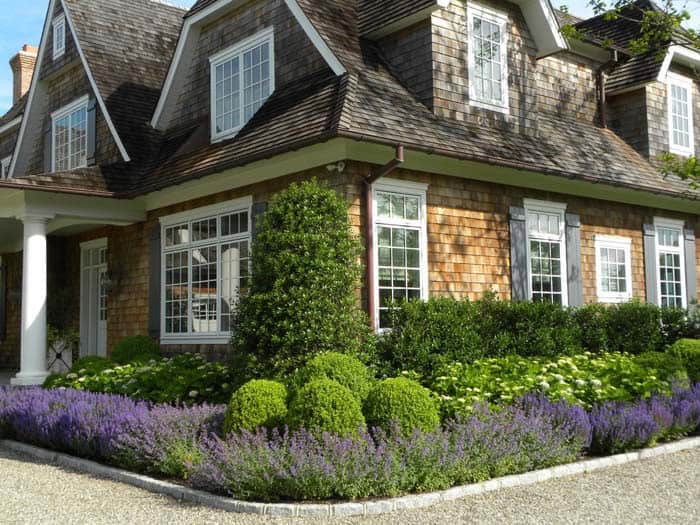
While a coastal home may be confronted with sandy soil, it’s still possible to create a multi-dimensional landscape. In fact, there are numerous landscaping ideas that can be implemented around your house to achieve this look.
The examples featured here include the strategic placement of evergreen shrubs towards the rear and a cohesive theme featuring sage plants in the front. This combination creates a visually appealing layered landscape that adds depth and interest to your outdoor space.
Layered Landscape Idea for a Small Yard
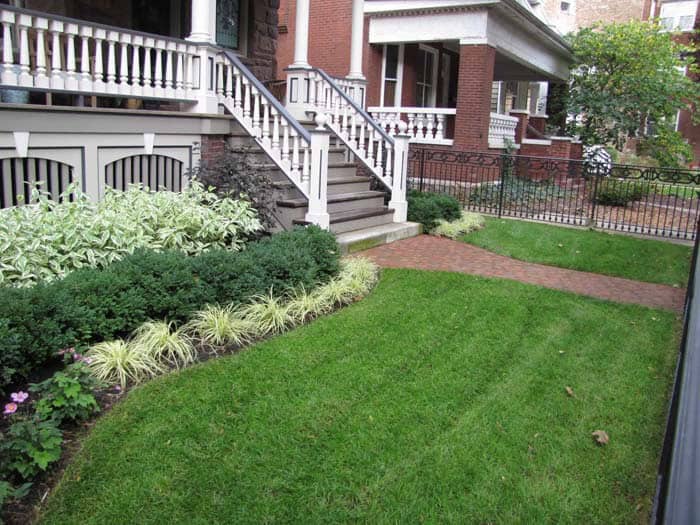
Transforming your small yard into a multi-layered oasis can revolutionize lawn maintenance, while also elevating the overall curb appeal of your property. Take, for instance, this exemplary three-tiered garden design that effortlessly blends functionality with visual allure.
Work With the Entire View
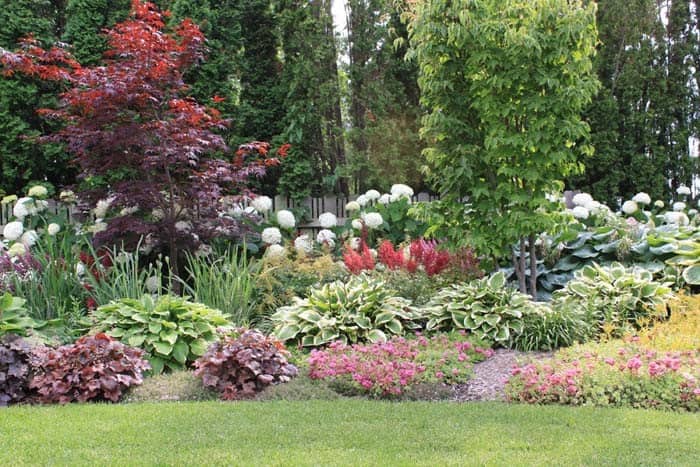
When designing layered landscaping, one common challenge arises from existing established trees that don’t provide sufficient height to work with. To overcome this obstacle, consider incorporating medium-height trees and shrubs alongside taller white flowers that resemble a ribbon tying the different layers together, creating a visually appealing and cohesive design.
Layered Landscape With Privacy and Balance
The challenge of achieving a harmonious landscape lies in striking a balance between visual elements without appearing contrived. In this garden, for instance, the placement of a tall tree at its center, accompanied by a prominent shrub to the right, resulted in an unbalanced composition. To rectify this, a Japanese maple was strategically planted on the left side, while evergreen shrubs were carefully chosen to connect the three main plants, thus restoring equilibrium and visual cohesion.
Layered Landscape Idea for a Border Garden
As you gaze upon this picturesque garden bed, your attention is drawn to the vibrant flowering shrubs that add depth and dimensionality to the space. Meanwhile, the palm trees and lush tropical plants in the background provide an impressive visual lift, creating a harmonious balance between the two.
Layered Landscaping on a Slope
Transforming your outdoor space, building a raised garden bed with a retaining wall on a sloping yard can create the illusion of a cozy courtyard. To achieve this, each plant selection is deliberate and well-planned, ensuring a harmonious visual experience that requires minimal maintenance.
Layered Landscape Works Vertically
Among the various layered landscaping ideas presented here, one notable feature is the classic garden bed situated in the far corner. This design element stands out from the rest with its well-structured layers, which effectively create a visually appealing display. In contrast, the section of the garden bed adjacent to the fence presents an interesting visual dynamic by employing vertical layering.
Here, the height is deliberately positioned at the center of the fence line, while the middle and front layers elegantly drape off to either side, thereby adding a touch of visual interest for anyone strolling along the border of the lawn.
Hide The Porch Skirting with Layered Landscape
When designing a layered garden, incorporating perennials is an excellent way to achieve low-maintenance landscaping. While evergreen shrubs are often used as the foundation layer, flowering shrubs can also provide a beautiful and vibrant alternative.
Classic Layered Landscape Flower Bed
When it comes to designing larger garden beds, incorporating an evergreen shrub at the rear can be a game-changer. Not only does it add visual interest, but it also simplifies maintenance by creating a natural border that’s easy to tend to. This thoughtful touch can make all the difference in a lush and inviting landscape.
Layered Landscape Keeps Rows Intact
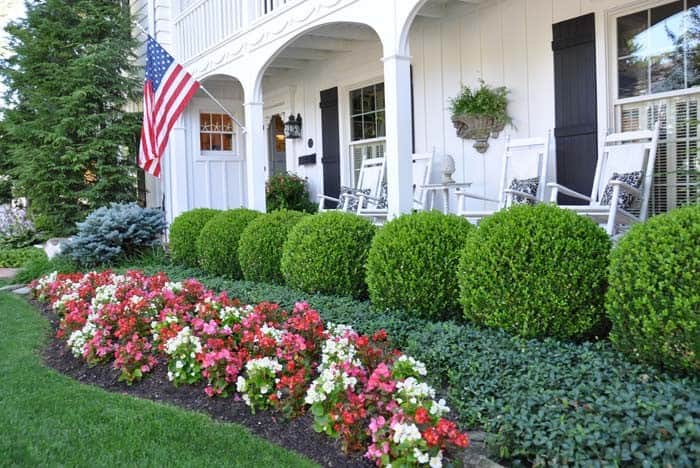
When it comes to landscape layering, one of the key decisions is how to balance interweaving and separation. In this case, Boxwood shrubs form the foundation, carefully pruned to maintain a low profile that doesn’t obstruct the view from the veranda. Meanwhile, Wax begonias bring a pop of bright color to the foreground, creating visual harmony through their contrasting heights.
A Rock Garden with a Layered Landscape
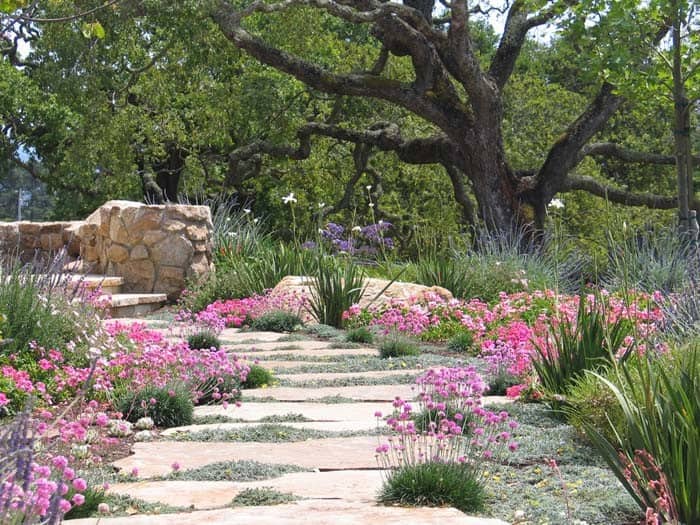
To add depth and visual interest to a rock garden, consider applying layered landscaping ideas that extend beyond the path. Whether your path is flat or meanders up a slope, you can create a dynamic landscape by building outwards from it. One effective way to achieve this is by using stepping stones as a pathway, which allows visitors to wind their way through the space. Flanking each side of the path with native plants adds natural beauty and interest.
To introduce pops of color, consider incorporating plants like Ameria or Sea Thrift into your design. Meanwhile, use low-growing groundcovers like Silver Carpet to fill in gaps between rocks and create a lush, verdant feel.
Full Yard of Layered Landscaping
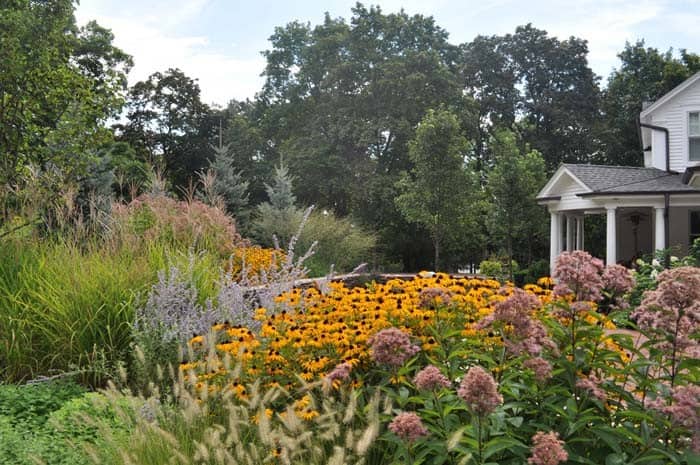
The garden’s layered design is cleverly defined by a natural rock wall, which provides a striking backdrop for the vibrant flowers. The juxtaposition of the grand collection of Black Eye Susans creates a sense of bookends, meeting at the stone boundary and framing the space beautifully.
Layered Landscape in a Pool’s Transitional Area
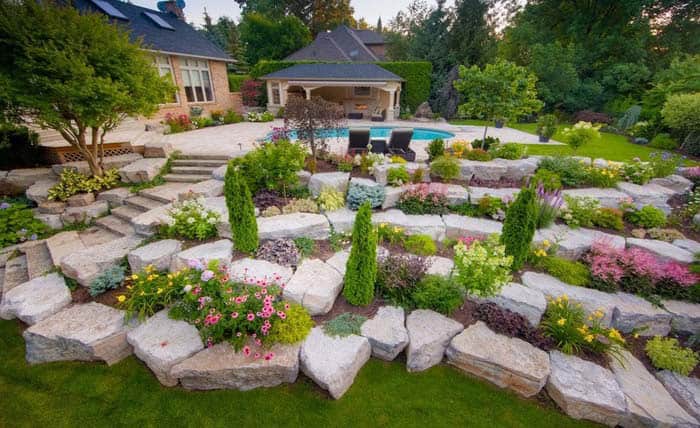
When designing a landscape that slopes, incorporating a rock garden can be an effective solution. This approach not only addresses issues related to erosion and lawn maintenance but also presents an opportunity to create visually appealing layers using stepping stones.
Plant Coleus for a Low Maintenance Layered Landscape
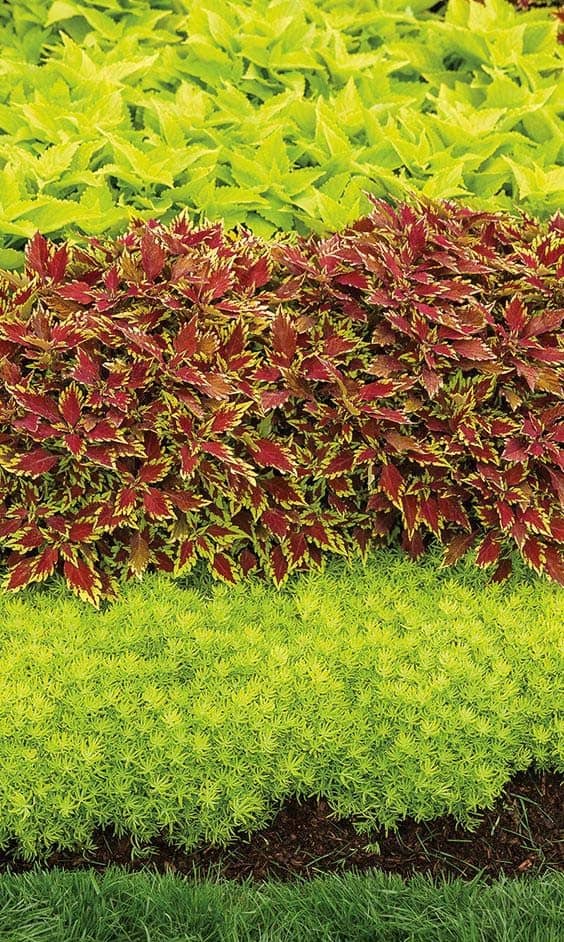
Transform your outdoor space with a low-maintenance layered garden featuring perennial bulbs. Perennials like Coleus, which can thrive in both full sun and partial shade settings, are perfect for borders that weave in and out of shady trees. In this design, the backdrop features Lime Time Coleus, which grows up to three feet tall.
A layer of Stonecrop adds visual interest at the front, while Grande ColorBlaze Apple Brandy Coleus serves as a mid-layer, cleverly tying together the yellow-green hues of the outer layers. This harmonious arrangement is thanks to Proven Winners’ expertise.
Mums Bring the Color to a Layered Landscape
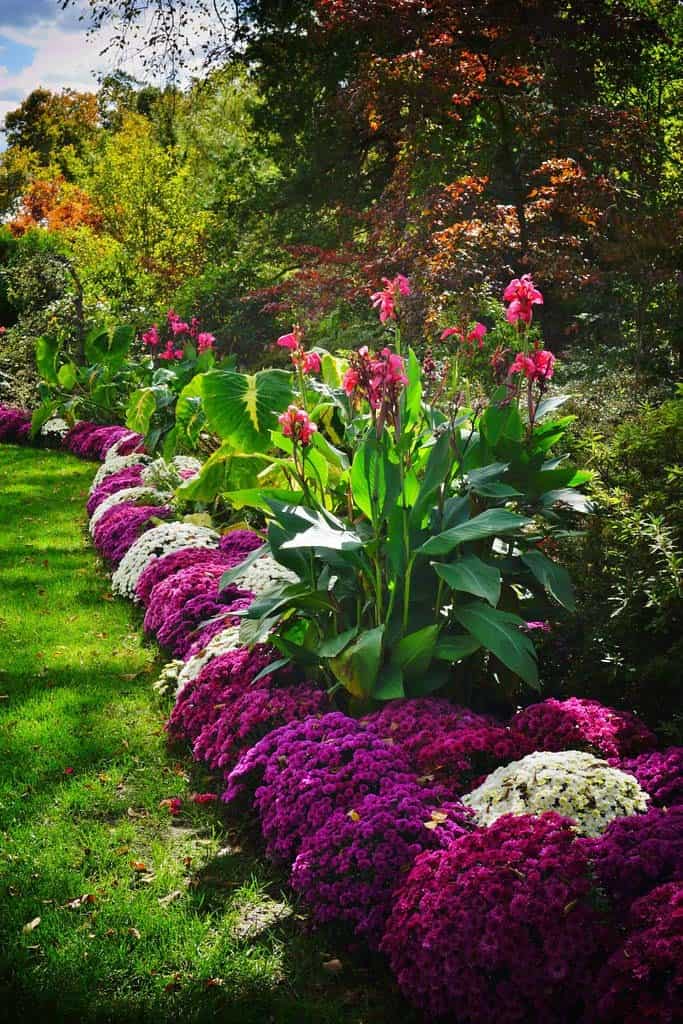
A striking visual element can be achieved by creating a garden border that incorporates mums to cover the soil. The focal point of this design is the azaleas, which rise up in the middle and add height and an air of sophistication to the overall aesthetic when viewed from the side. This dramatic landscaping idea makes for a beautiful and memorable display.
Alternating Colors in a Garden Bed
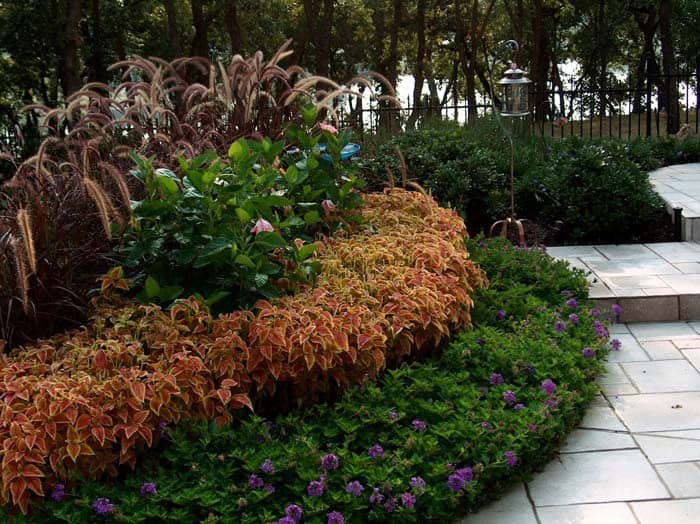
The concept of alternating colors is another effective landscape layering technique. By combining flowering plants with Coleus and Purple fountain grass in a harmonious sequence, a visually appealing display can be created. This approach ensures that even when the flowers have dropped in the fall, the alternating layers of color will remain, maintaining the garden’s aesthetic appeal.
Meticulous Garden Bed with Boxwood Layers
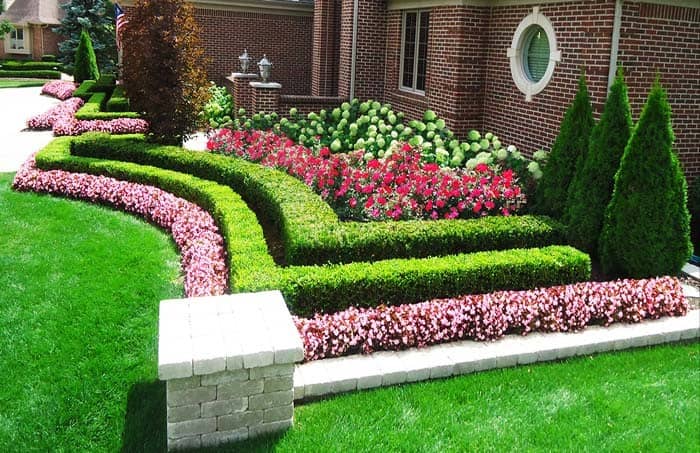
When it comes to formal landscaping, a key consideration is selecting plants that can be easily pruned and maintained to maintain their shape. One approach is to incorporate perennial flowering shrubs like hydrangeas into the design, which can be readily trimmed back as needed. Additionally, using boxwoods in multiple layers – such as for mid-level plantings – and strategically placing trees on the foundation’s corners can help create a cohesive look.
Furthermore, incorporating simple features like white brick edging along the lawn’s perimeter can simplify maintenance tasks and enhance the overall aesthetic.
Layered Landscaping Creates a Wild Look
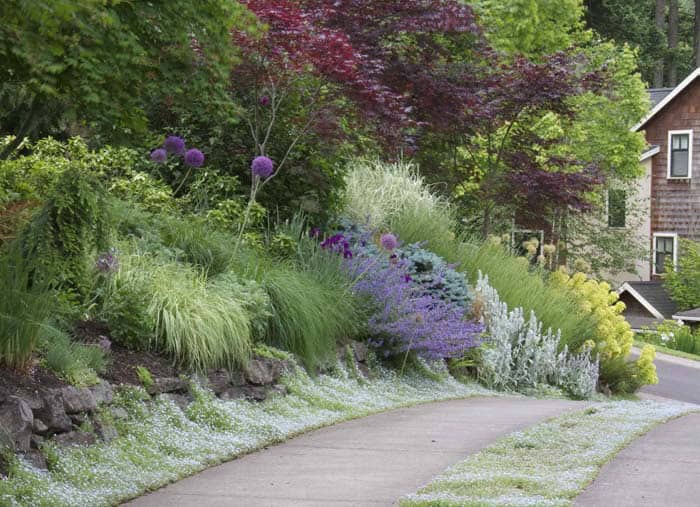
The raised garden’s multi-layered design creates a lush atmosphere, perfect for showcasing drought-tolerant plants like sage, Giant allium, and Japanese forest grass. The trees above provide a natural canopy, while white creeping thyme or Silver Falls Dichondra ground covers on either side of the sidewalk enhance the overall aesthetic.
Add Color In the Back With Flowering Shrubs
A well-designed garden border is a hallmark of a beautifully manicured lawn. The key to achieving this look is through strategic layering of different elements. In this example, the owners started by incorporating a small tree and rhododendrons towards the back of the border, providing a natural backdrop for the rest of the design. As you move forward, boxwoods were added to create a mid-layer that adds depth and visual interest.
For the front layer, any number of yellow flowering plants could be used, such as perennial yellow roses, wax begonias, or peonies, adding a pop of color and completing the look.
Layered Landscape Brings Big Curb Appeal
A small garden can be just as visually stunning as a larger landscape, with a little creativity. To achieve this, focus on covering the foundation corners and ensure that the height of the background layer remains below the window sill level. One doesn’t need to incorporate trees; ornamental grasses like Silver Grass or Dwarf Maiden Zebra Grass can add interesting texture and visual interest, as seen in the right corner of a well-designed small garden.
To bring color and vibrancy to the foreground layer, consider using carpet flowers like Dwarf Crepe Myrtle, which can add a pop of color and create a welcoming atmosphere.

